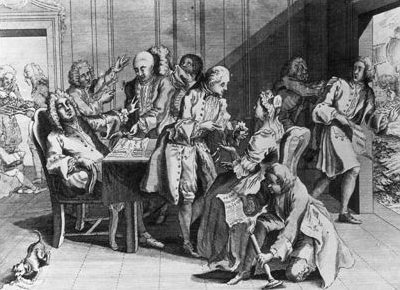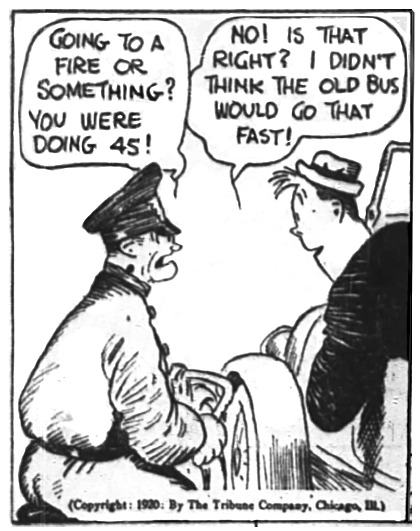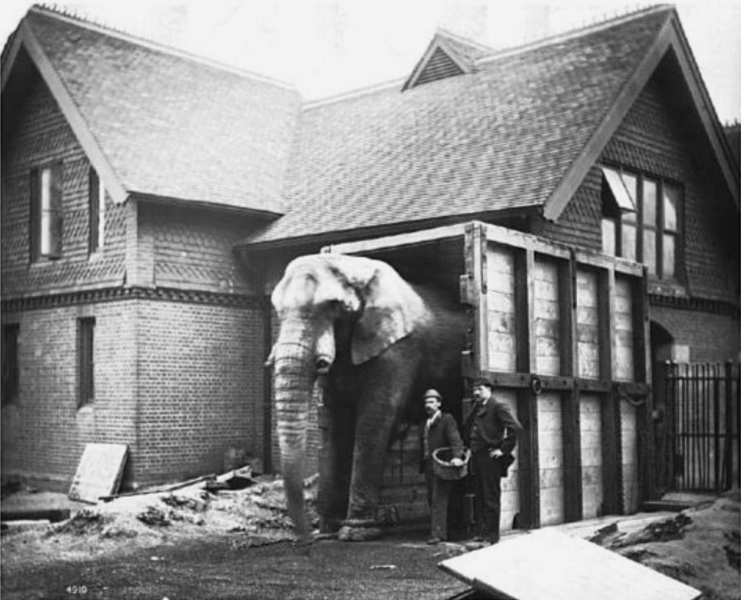Jumbo the Elephant Comes to the US, 1882
If you've ever heard of Jumbo the Elephant, you probably think that he got his name because of his tremendous size. The truth is exactly the opposite --the word jumbo was derived from the elephant's name.Jumbo was only a baby when he was captured in Abyssinia in 1861. He was sold to a wild animal collector, who later sold him to the Paris zoo at the Jardin des Plantes. In 1865 he was visited by a London zookeeper named Matthew Scott. Scott saw that Jumbo and another elephant were ill, and thought that he could cure them. He arranged for a trade -- the London zoo received the two elephants in exchange for a rhinoceros. Matthew Scott would be Jumbo's caretaker for the rest of Jumbo's life.
The elephant quickly returned to health and was a great favorite at the London zoo, especially among the children. It was at the London zoo that he was named "Jumbo", a word derived from two Swahili words: jambo, which means hello, and jumbe, or chief.
When P. T. Barnum visited the zoo in 1882, he saw in the elephant a great potential. He purchased him from the zoo for $10,000, over the great protests of the people of London. It cost him another $20,000 to get the elephant back to America.
As Barnum foresaw, Jumbo was a great hit. Barnum quickly recouped his purchase price, exhibiting Jumbo at Madison Square Garden. After that, he toured with the circus, becoming a favorite everywhere he went.
In 1885 Jumbo was killed by a locomotive in St. Thomas, Ontario. Jumbo was being led down the track to his specially-built car, along with a smaller, clown elephant named Tom Thumb. The railway worker whose job it was to flag down the oncoming locomotive had left his post in order to watch the elephants, and was unable to stop the locomotive in time. Scott saw the oncoming disaster, and shouted, "Run, Jumbo, run!" Jumbo ran toward the gap in the fence where he had just entered, but overshot it. When he turned to come back, he was struck by the oncoming train.
 |
| Jumbo in 1865. (That's Matthew Scott with him.) |
Barnum had Jumbo stuffed and mounted, and he toured with the circus as an exhibit for another two years. After that, Barnum donated his remains to Tufts University, no doubt in order to generate further publicity. The stuffed Jumbo became a good luck symbol to students at Tufts, and they often tugged on his tail before a critical game or exam. His tail had to be replaced in 1942, and the original was put into storage.
Consequently, it was only Jumbo's original tail that survived when the Tufts museum burned in 1975. Some ashes of Jumbo were collected by a member of the Tufts Athletic Department. They currently reside in the office of the athletic director, stored in a 14-ounce Peter Pan Crunchy Peanut Butter jar.
 |
| Jenkins showing the Prime Minister his severed ear. |
Jenkins Loses an Ear, 1731
The British Captain Robert Jenkins was returning home from the West Indies in 1731 when he was stopped by a Spanish ship under the command of Captain Julio Leon Fandino. Fandino had Jenkins bound to a mast and then cut off one of his ears, instructing him to tell the king "that I will do the same, if he dares to do the same."What was this all about? Well, the background goes back to the War of the Spanish Succession, in the early 1700's. At the conclusion of that war, the British were given the right of asiento, the right to sell an unlimited number of slaves to the Spanish colonies, along with another 500 tons of goods. As you can imagine, British smugglers and legitimate traders both abused this right to bring in additional trade goods. The Spanish objected, and conditions were volatile.
After losing his ear, Jenkins returned to England, arriving in June and notifying the King and his advisors of the incident. The following spring he addressed Parliament on the issue, and produced his ear, which he had pickled and kept in a jar. Parliament voted to advise the King to take action against the Spanish.
The resulting war was popularly called "The War of Jenkins Ear" and continued until 1742, when it became part of the conflict known as the War of the Austrian Succession, in which most of the powers of Europe participated.
 |
| Frank Wallet in 1920. |
Frank King's Birthday, 1883
Frank King was the creator of the comic strip Gasoline Alley. Gasoline Alley was the first comic strip where the characters aged normally, grew up, and passed through generations.He began the strip in 1918, in the Sunday comic page of The Chicago Tribune. It became a daily strip in 1919 in the New York Daily Times. The early strips were about Walt Wallet and his cronies. Later, King wanted to add a child to the strip, but he didn't want to have Walt marry, so he arranged for him to find a child on his doorstep. That was the first appearance of Skeezix, who would later grow up, fight in World War II, marry, and have children of his own. (Walt also married, eventually.)
Although Frank King died in 1969, the strip is still published. King was succeeded by Bill Perry and Dick Moores, and is currently written and drawn by Jim Scancarelli.

No comments:
Post a Comment